Comparative Business Ethics and Social Responsibility in Oil and Gas
VerifiedAdded on 2019/11/20
|13
|4209
|214
Report
AI Summary
This report provides an executive summary and analysis of business ethics and social responsibility within the oil and gas industry, focusing on sustainability changes, risks, and solutions. The report addresses managing ethical risks to reduce accidents, compares the risks faced by companies like Exxon and BP, and evaluates the effectiveness of ethical leadership in managing these risks. It covers topics such as stakeholder protection, environmental impact, and the importance of safety measures like training and remote control systems. The report also considers the negative impacts of oil spills, fracking, and the need for a strong safety culture within these companies, concluding with a discussion on risk comparison and the challenges faced by the industry.
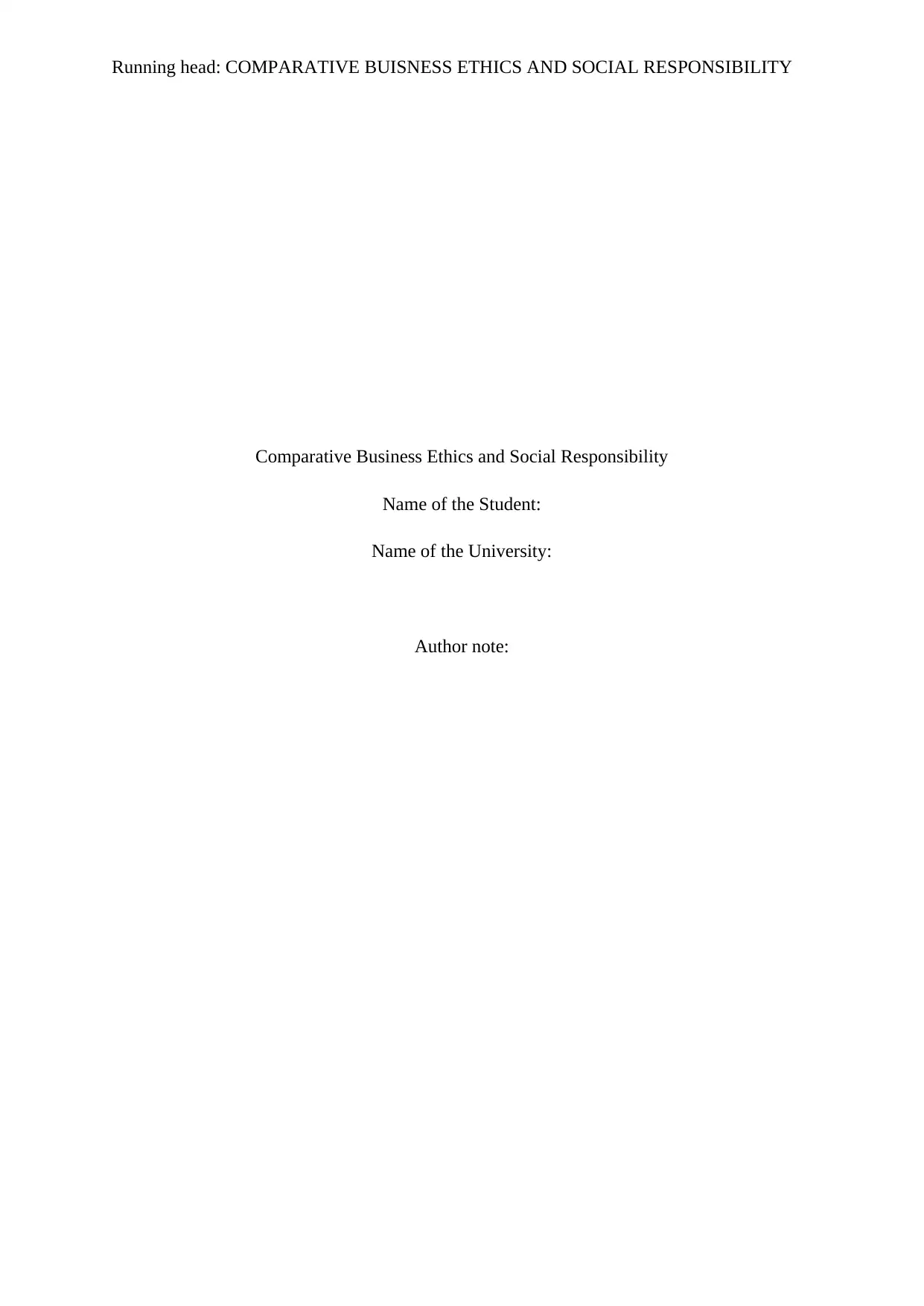
Running head: COMPARATIVE BUISNESS ETHICS AND SOCIAL RESPONSIBILITY
Comparative Business Ethics and Social Responsibility
Name of the Student:
Name of the University:
Author note:
Comparative Business Ethics and Social Responsibility
Name of the Student:
Name of the University:
Author note:
Paraphrase This Document
Need a fresh take? Get an instant paraphrase of this document with our AI Paraphraser
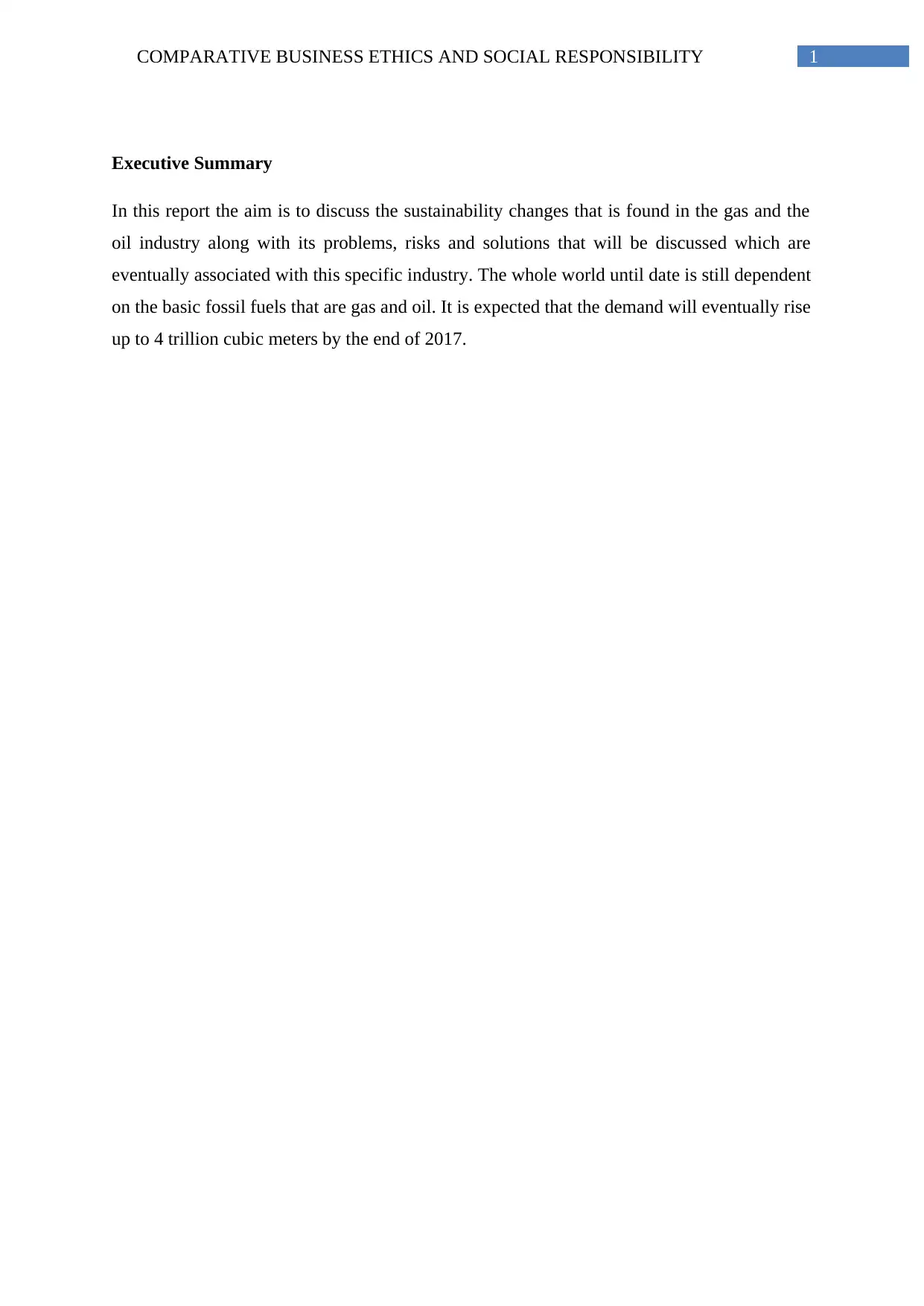
1COMPARATIVE BUSINESS ETHICS AND SOCIAL RESPONSIBILITY
Executive Summary
In this report the aim is to discuss the sustainability changes that is found in the gas and the
oil industry along with its problems, risks and solutions that will be discussed which are
eventually associated with this specific industry. The whole world until date is still dependent
on the basic fossil fuels that are gas and oil. It is expected that the demand will eventually rise
up to 4 trillion cubic meters by the end of 2017.
Executive Summary
In this report the aim is to discuss the sustainability changes that is found in the gas and the
oil industry along with its problems, risks and solutions that will be discussed which are
eventually associated with this specific industry. The whole world until date is still dependent
on the basic fossil fuels that are gas and oil. It is expected that the demand will eventually rise
up to 4 trillion cubic meters by the end of 2017.
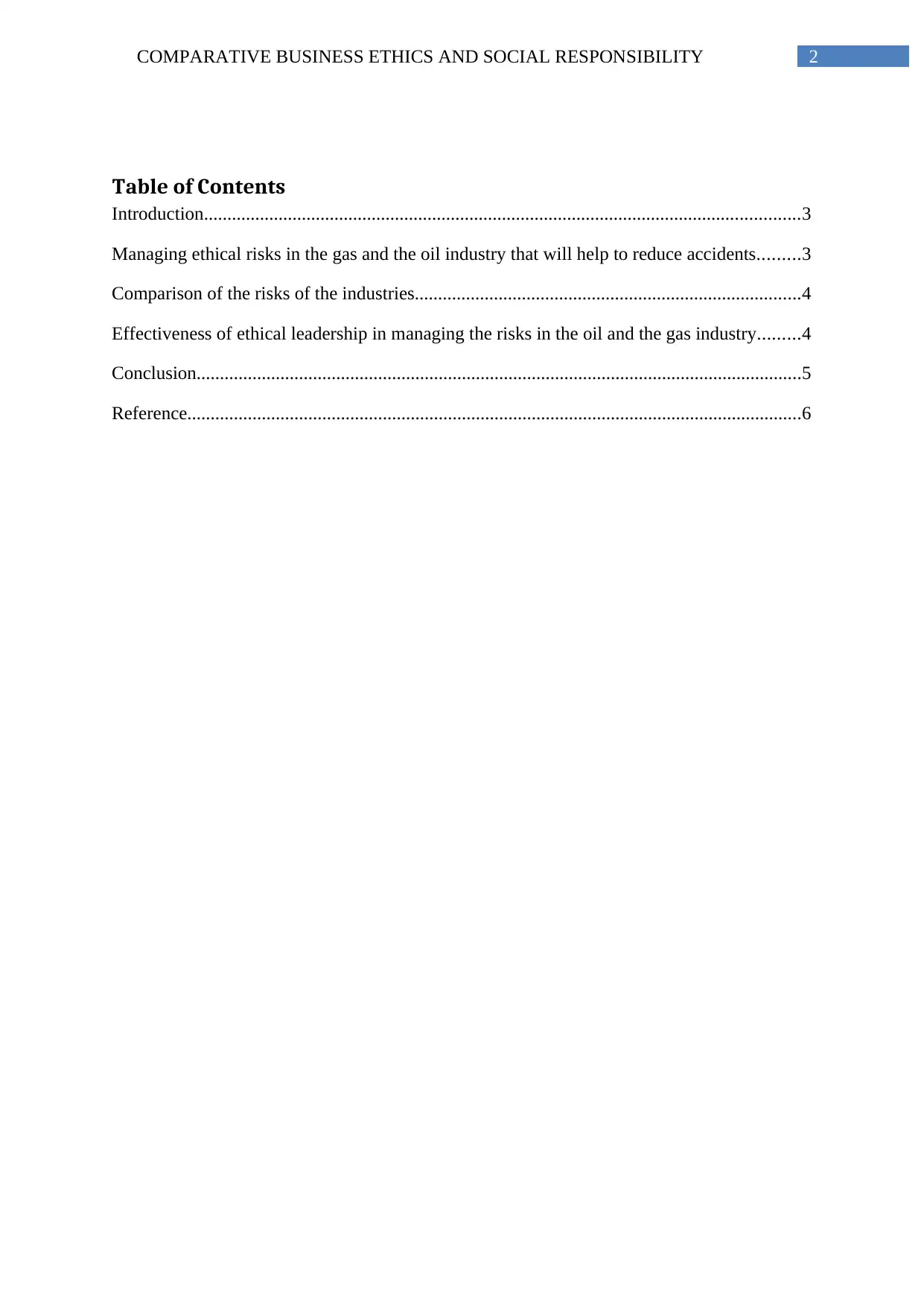
2COMPARATIVE BUSINESS ETHICS AND SOCIAL RESPONSIBILITY
Table of Contents
Introduction................................................................................................................................3
Managing ethical risks in the gas and the oil industry that will help to reduce accidents.........3
Comparison of the risks of the industries...................................................................................4
Effectiveness of ethical leadership in managing the risks in the oil and the gas industry.........4
Conclusion..................................................................................................................................5
Reference....................................................................................................................................6
Table of Contents
Introduction................................................................................................................................3
Managing ethical risks in the gas and the oil industry that will help to reduce accidents.........3
Comparison of the risks of the industries...................................................................................4
Effectiveness of ethical leadership in managing the risks in the oil and the gas industry.........4
Conclusion..................................................................................................................................5
Reference....................................................................................................................................6
You're viewing a preview
Unlock full access by subscribing today!
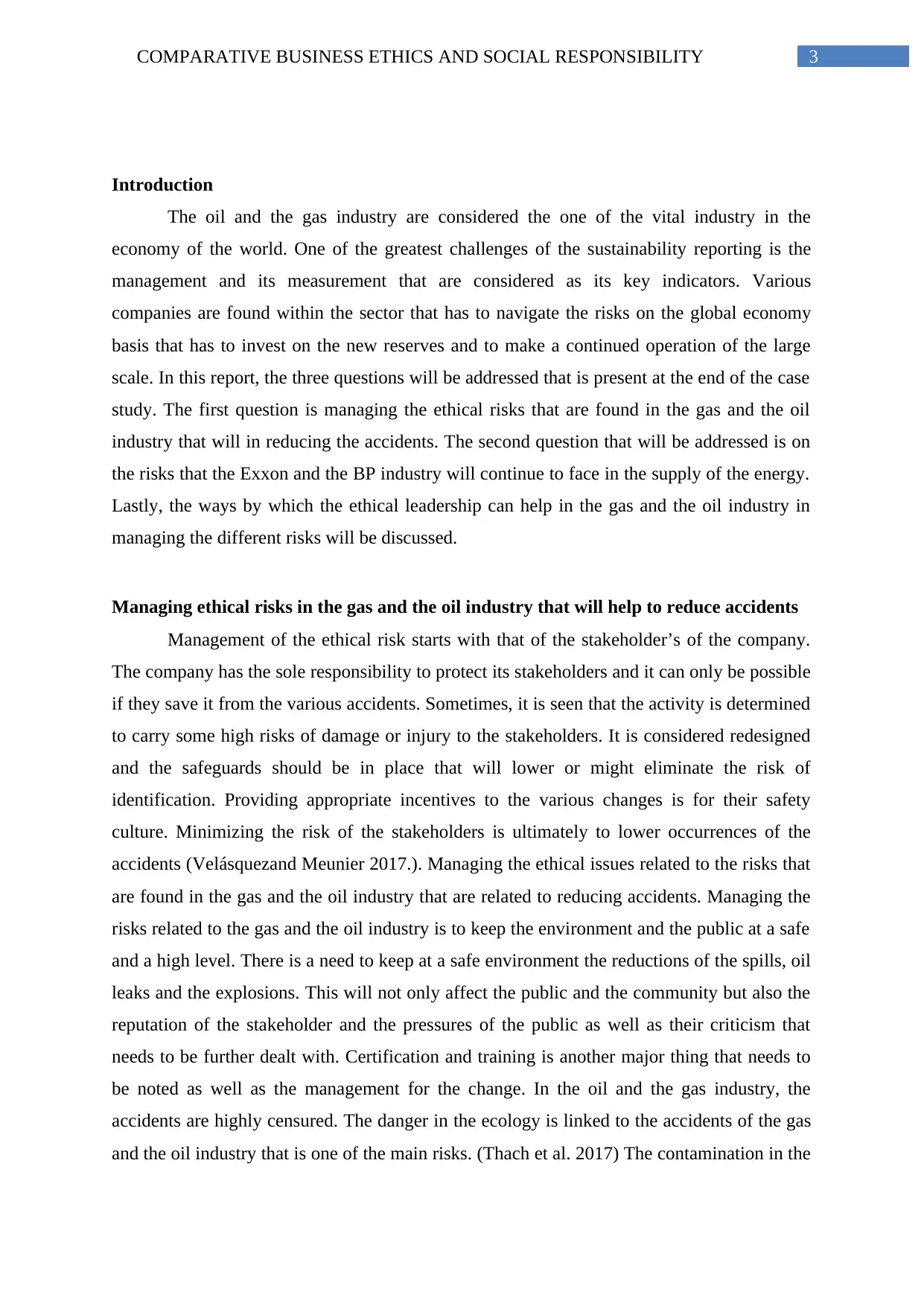
3COMPARATIVE BUSINESS ETHICS AND SOCIAL RESPONSIBILITY
Introduction
The oil and the gas industry are considered the one of the vital industry in the
economy of the world. One of the greatest challenges of the sustainability reporting is the
management and its measurement that are considered as its key indicators. Various
companies are found within the sector that has to navigate the risks on the global economy
basis that has to invest on the new reserves and to make a continued operation of the large
scale. In this report, the three questions will be addressed that is present at the end of the case
study. The first question is managing the ethical risks that are found in the gas and the oil
industry that will in reducing the accidents. The second question that will be addressed is on
the risks that the Exxon and the BP industry will continue to face in the supply of the energy.
Lastly, the ways by which the ethical leadership can help in the gas and the oil industry in
managing the different risks will be discussed.
Managing ethical risks in the gas and the oil industry that will help to reduce accidents
Management of the ethical risk starts with that of the stakeholder’s of the company.
The company has the sole responsibility to protect its stakeholders and it can only be possible
if they save it from the various accidents. Sometimes, it is seen that the activity is determined
to carry some high risks of damage or injury to the stakeholders. It is considered redesigned
and the safeguards should be in place that will lower or might eliminate the risk of
identification. Providing appropriate incentives to the various changes is for their safety
culture. Minimizing the risk of the stakeholders is ultimately to lower occurrences of the
accidents (Velásquezand Meunier 2017.). Managing the ethical issues related to the risks that
are found in the gas and the oil industry that are related to reducing accidents. Managing the
risks related to the gas and the oil industry is to keep the environment and the public at a safe
and a high level. There is a need to keep at a safe environment the reductions of the spills, oil
leaks and the explosions. This will not only affect the public and the community but also the
reputation of the stakeholder and the pressures of the public as well as their criticism that
needs to be further dealt with. Certification and training is another major thing that needs to
be noted as well as the management for the change. In the oil and the gas industry, the
accidents are highly censured. The danger in the ecology is linked to the accidents of the gas
and the oil industry that is one of the main risks. (Thach et al. 2017) The contamination in the
Introduction
The oil and the gas industry are considered the one of the vital industry in the
economy of the world. One of the greatest challenges of the sustainability reporting is the
management and its measurement that are considered as its key indicators. Various
companies are found within the sector that has to navigate the risks on the global economy
basis that has to invest on the new reserves and to make a continued operation of the large
scale. In this report, the three questions will be addressed that is present at the end of the case
study. The first question is managing the ethical risks that are found in the gas and the oil
industry that will in reducing the accidents. The second question that will be addressed is on
the risks that the Exxon and the BP industry will continue to face in the supply of the energy.
Lastly, the ways by which the ethical leadership can help in the gas and the oil industry in
managing the different risks will be discussed.
Managing ethical risks in the gas and the oil industry that will help to reduce accidents
Management of the ethical risk starts with that of the stakeholder’s of the company.
The company has the sole responsibility to protect its stakeholders and it can only be possible
if they save it from the various accidents. Sometimes, it is seen that the activity is determined
to carry some high risks of damage or injury to the stakeholders. It is considered redesigned
and the safeguards should be in place that will lower or might eliminate the risk of
identification. Providing appropriate incentives to the various changes is for their safety
culture. Minimizing the risk of the stakeholders is ultimately to lower occurrences of the
accidents (Velásquezand Meunier 2017.). Managing the ethical issues related to the risks that
are found in the gas and the oil industry that are related to reducing accidents. Managing the
risks related to the gas and the oil industry is to keep the environment and the public at a safe
and a high level. There is a need to keep at a safe environment the reductions of the spills, oil
leaks and the explosions. This will not only affect the public and the community but also the
reputation of the stakeholder and the pressures of the public as well as their criticism that
needs to be further dealt with. Certification and training is another major thing that needs to
be noted as well as the management for the change. In the oil and the gas industry, the
accidents are highly censured. The danger in the ecology is linked to the accidents of the gas
and the oil industry that is one of the main risks. (Thach et al. 2017) The contamination in the
Paraphrase This Document
Need a fresh take? Get an instant paraphrase of this document with our AI Paraphraser
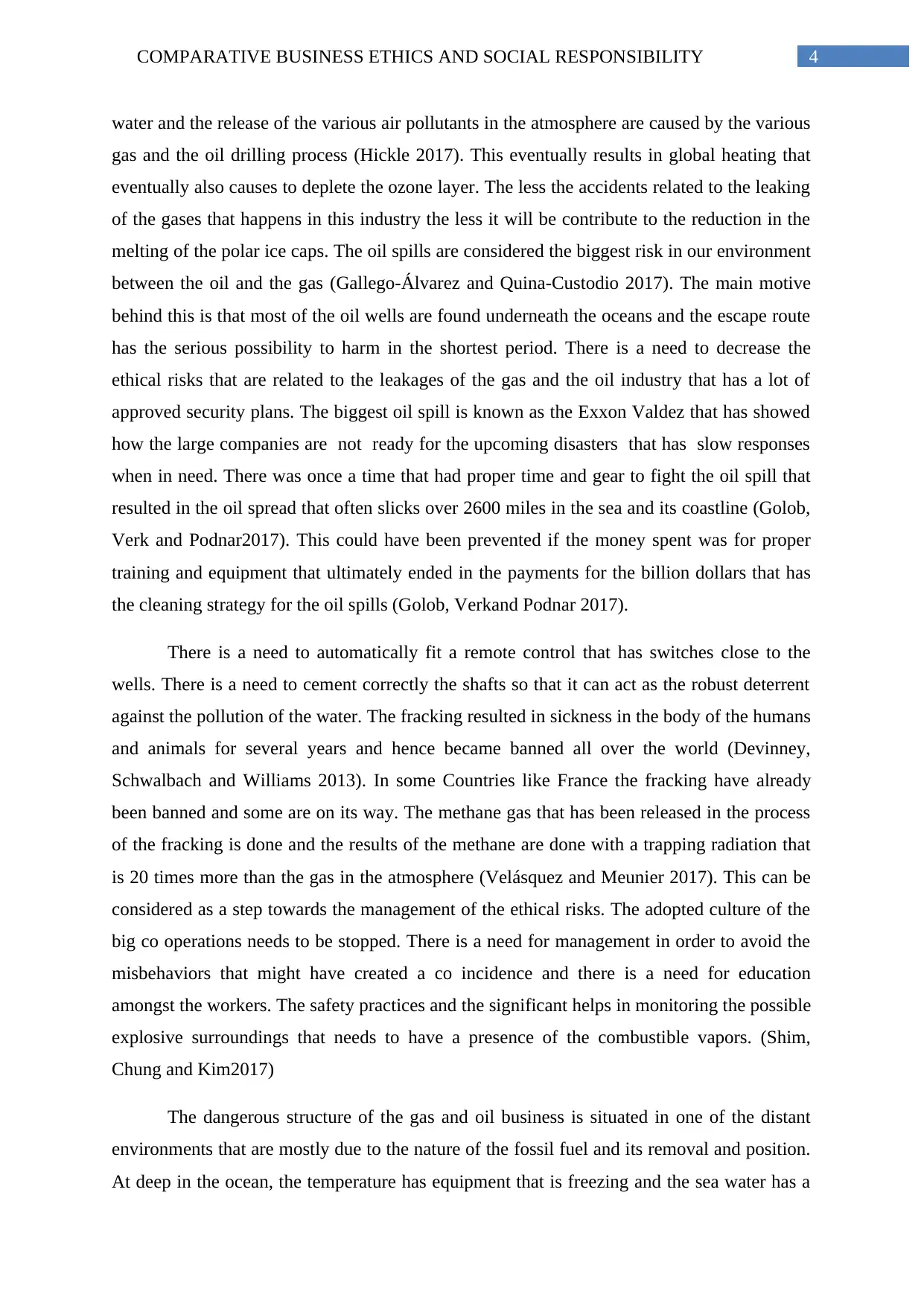
4COMPARATIVE BUSINESS ETHICS AND SOCIAL RESPONSIBILITY
water and the release of the various air pollutants in the atmosphere are caused by the various
gas and the oil drilling process (Hickle 2017). This eventually results in global heating that
eventually also causes to deplete the ozone layer. The less the accidents related to the leaking
of the gases that happens in this industry the less it will be contribute to the reduction in the
melting of the polar ice caps. The oil spills are considered the biggest risk in our environment
between the oil and the gas (Gallego‐Álvarez and Quina‐Custodio 2017). The main motive
behind this is that most of the oil wells are found underneath the oceans and the escape route
has the serious possibility to harm in the shortest period. There is a need to decrease the
ethical risks that are related to the leakages of the gas and the oil industry that has a lot of
approved security plans. The biggest oil spill is known as the Exxon Valdez that has showed
how the large companies are not ready for the upcoming disasters that has slow responses
when in need. There was once a time that had proper time and gear to fight the oil spill that
resulted in the oil spread that often slicks over 2600 miles in the sea and its coastline (Golob,
Verk and Podnar2017). This could have been prevented if the money spent was for proper
training and equipment that ultimately ended in the payments for the billion dollars that has
the cleaning strategy for the oil spills (Golob, Verkand Podnar 2017).
There is a need to automatically fit a remote control that has switches close to the
wells. There is a need to cement correctly the shafts so that it can act as the robust deterrent
against the pollution of the water. The fracking resulted in sickness in the body of the humans
and animals for several years and hence became banned all over the world (Devinney,
Schwalbach and Williams 2013). In some Countries like France the fracking have already
been banned and some are on its way. The methane gas that has been released in the process
of the fracking is done and the results of the methane are done with a trapping radiation that
is 20 times more than the gas in the atmosphere (Velásquez and Meunier 2017). This can be
considered as a step towards the management of the ethical risks. The adopted culture of the
big co operations needs to be stopped. There is a need for management in order to avoid the
misbehaviors that might have created a co incidence and there is a need for education
amongst the workers. The safety practices and the significant helps in monitoring the possible
explosive surroundings that needs to have a presence of the combustible vapors. (Shim,
Chung and Kim2017)
The dangerous structure of the gas and oil business is situated in one of the distant
environments that are mostly due to the nature of the fossil fuel and its removal and position.
At deep in the ocean, the temperature has equipment that is freezing and the sea water has a
water and the release of the various air pollutants in the atmosphere are caused by the various
gas and the oil drilling process (Hickle 2017). This eventually results in global heating that
eventually also causes to deplete the ozone layer. The less the accidents related to the leaking
of the gases that happens in this industry the less it will be contribute to the reduction in the
melting of the polar ice caps. The oil spills are considered the biggest risk in our environment
between the oil and the gas (Gallego‐Álvarez and Quina‐Custodio 2017). The main motive
behind this is that most of the oil wells are found underneath the oceans and the escape route
has the serious possibility to harm in the shortest period. There is a need to decrease the
ethical risks that are related to the leakages of the gas and the oil industry that has a lot of
approved security plans. The biggest oil spill is known as the Exxon Valdez that has showed
how the large companies are not ready for the upcoming disasters that has slow responses
when in need. There was once a time that had proper time and gear to fight the oil spill that
resulted in the oil spread that often slicks over 2600 miles in the sea and its coastline (Golob,
Verk and Podnar2017). This could have been prevented if the money spent was for proper
training and equipment that ultimately ended in the payments for the billion dollars that has
the cleaning strategy for the oil spills (Golob, Verkand Podnar 2017).
There is a need to automatically fit a remote control that has switches close to the
wells. There is a need to cement correctly the shafts so that it can act as the robust deterrent
against the pollution of the water. The fracking resulted in sickness in the body of the humans
and animals for several years and hence became banned all over the world (Devinney,
Schwalbach and Williams 2013). In some Countries like France the fracking have already
been banned and some are on its way. The methane gas that has been released in the process
of the fracking is done and the results of the methane are done with a trapping radiation that
is 20 times more than the gas in the atmosphere (Velásquez and Meunier 2017). This can be
considered as a step towards the management of the ethical risks. The adopted culture of the
big co operations needs to be stopped. There is a need for management in order to avoid the
misbehaviors that might have created a co incidence and there is a need for education
amongst the workers. The safety practices and the significant helps in monitoring the possible
explosive surroundings that needs to have a presence of the combustible vapors. (Shim,
Chung and Kim2017)
The dangerous structure of the gas and oil business is situated in one of the distant
environments that are mostly due to the nature of the fossil fuel and its removal and position.
At deep in the ocean, the temperature has equipment that is freezing and the sea water has a
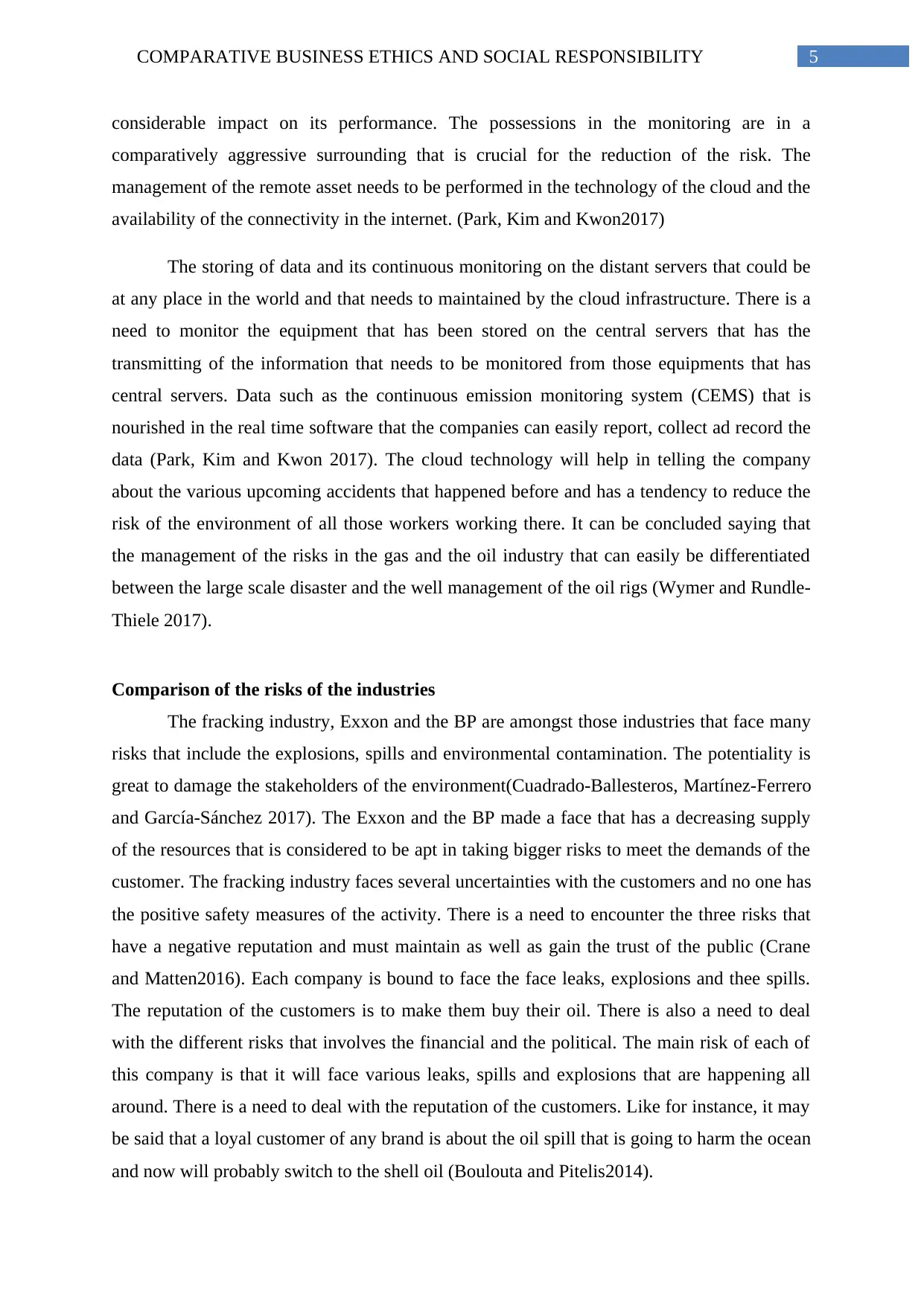
5COMPARATIVE BUSINESS ETHICS AND SOCIAL RESPONSIBILITY
considerable impact on its performance. The possessions in the monitoring are in a
comparatively aggressive surrounding that is crucial for the reduction of the risk. The
management of the remote asset needs to be performed in the technology of the cloud and the
availability of the connectivity in the internet. (Park, Kim and Kwon2017)
The storing of data and its continuous monitoring on the distant servers that could be
at any place in the world and that needs to maintained by the cloud infrastructure. There is a
need to monitor the equipment that has been stored on the central servers that has the
transmitting of the information that needs to be monitored from those equipments that has
central servers. Data such as the continuous emission monitoring system (CEMS) that is
nourished in the real time software that the companies can easily report, collect ad record the
data (Park, Kim and Kwon 2017). The cloud technology will help in telling the company
about the various upcoming accidents that happened before and has a tendency to reduce the
risk of the environment of all those workers working there. It can be concluded saying that
the management of the risks in the gas and the oil industry that can easily be differentiated
between the large scale disaster and the well management of the oil rigs (Wymer and Rundle-
Thiele 2017).
Comparison of the risks of the industries
The fracking industry, Exxon and the BP are amongst those industries that face many
risks that include the explosions, spills and environmental contamination. The potentiality is
great to damage the stakeholders of the environment(Cuadrado‐Ballesteros, Martínez‐Ferrero
and García‐Sánchez 2017). The Exxon and the BP made a face that has a decreasing supply
of the resources that is considered to be apt in taking bigger risks to meet the demands of the
customer. The fracking industry faces several uncertainties with the customers and no one has
the positive safety measures of the activity. There is a need to encounter the three risks that
have a negative reputation and must maintain as well as gain the trust of the public (Crane
and Matten2016). Each company is bound to face the face leaks, explosions and thee spills.
The reputation of the customers is to make them buy their oil. There is also a need to deal
with the different risks that involves the financial and the political. The main risk of each of
this company is that it will face various leaks, spills and explosions that are happening all
around. There is a need to deal with the reputation of the customers. Like for instance, it may
be said that a loyal customer of any brand is about the oil spill that is going to harm the ocean
and now will probably switch to the shell oil (Boulouta and Pitelis2014).
considerable impact on its performance. The possessions in the monitoring are in a
comparatively aggressive surrounding that is crucial for the reduction of the risk. The
management of the remote asset needs to be performed in the technology of the cloud and the
availability of the connectivity in the internet. (Park, Kim and Kwon2017)
The storing of data and its continuous monitoring on the distant servers that could be
at any place in the world and that needs to maintained by the cloud infrastructure. There is a
need to monitor the equipment that has been stored on the central servers that has the
transmitting of the information that needs to be monitored from those equipments that has
central servers. Data such as the continuous emission monitoring system (CEMS) that is
nourished in the real time software that the companies can easily report, collect ad record the
data (Park, Kim and Kwon 2017). The cloud technology will help in telling the company
about the various upcoming accidents that happened before and has a tendency to reduce the
risk of the environment of all those workers working there. It can be concluded saying that
the management of the risks in the gas and the oil industry that can easily be differentiated
between the large scale disaster and the well management of the oil rigs (Wymer and Rundle-
Thiele 2017).
Comparison of the risks of the industries
The fracking industry, Exxon and the BP are amongst those industries that face many
risks that include the explosions, spills and environmental contamination. The potentiality is
great to damage the stakeholders of the environment(Cuadrado‐Ballesteros, Martínez‐Ferrero
and García‐Sánchez 2017). The Exxon and the BP made a face that has a decreasing supply
of the resources that is considered to be apt in taking bigger risks to meet the demands of the
customer. The fracking industry faces several uncertainties with the customers and no one has
the positive safety measures of the activity. There is a need to encounter the three risks that
have a negative reputation and must maintain as well as gain the trust of the public (Crane
and Matten2016). Each company is bound to face the face leaks, explosions and thee spills.
The reputation of the customers is to make them buy their oil. There is also a need to deal
with the different risks that involves the financial and the political. The main risk of each of
this company is that it will face various leaks, spills and explosions that are happening all
around. There is a need to deal with the reputation of the customers. Like for instance, it may
be said that a loyal customer of any brand is about the oil spill that is going to harm the ocean
and now will probably switch to the shell oil (Boulouta and Pitelis2014).
You're viewing a preview
Unlock full access by subscribing today!
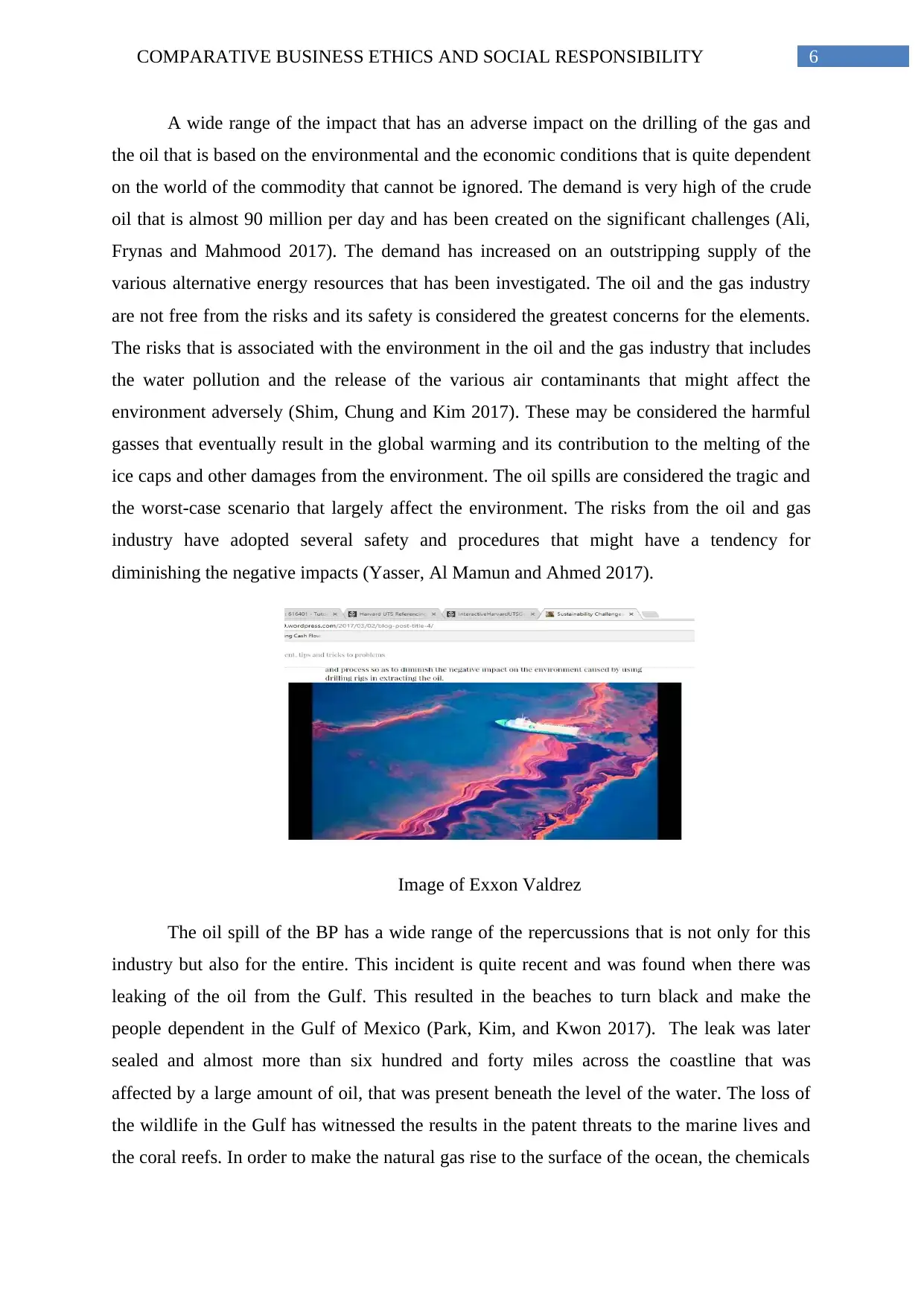
6COMPARATIVE BUSINESS ETHICS AND SOCIAL RESPONSIBILITY
A wide range of the impact that has an adverse impact on the drilling of the gas and
the oil that is based on the environmental and the economic conditions that is quite dependent
on the world of the commodity that cannot be ignored. The demand is very high of the crude
oil that is almost 90 million per day and has been created on the significant challenges (Ali,
Frynas and Mahmood 2017). The demand has increased on an outstripping supply of the
various alternative energy resources that has been investigated. The oil and the gas industry
are not free from the risks and its safety is considered the greatest concerns for the elements.
The risks that is associated with the environment in the oil and the gas industry that includes
the water pollution and the release of the various air contaminants that might affect the
environment adversely (Shim, Chung and Kim 2017). These may be considered the harmful
gasses that eventually result in the global warming and its contribution to the melting of the
ice caps and other damages from the environment. The oil spills are considered the tragic and
the worst-case scenario that largely affect the environment. The risks from the oil and gas
industry have adopted several safety and procedures that might have a tendency for
diminishing the negative impacts (Yasser, Al Mamun and Ahmed 2017).
Image of Exxon Valdrez
The oil spill of the BP has a wide range of the repercussions that is not only for this
industry but also for the entire. This incident is quite recent and was found when there was
leaking of the oil from the Gulf. This resulted in the beaches to turn black and make the
people dependent in the Gulf of Mexico (Park, Kim, and Kwon 2017). The leak was later
sealed and almost more than six hundred and forty miles across the coastline that was
affected by a large amount of oil, that was present beneath the level of the water. The loss of
the wildlife in the Gulf has witnessed the results in the patent threats to the marine lives and
the coral reefs. In order to make the natural gas rise to the surface of the ocean, the chemicals
A wide range of the impact that has an adverse impact on the drilling of the gas and
the oil that is based on the environmental and the economic conditions that is quite dependent
on the world of the commodity that cannot be ignored. The demand is very high of the crude
oil that is almost 90 million per day and has been created on the significant challenges (Ali,
Frynas and Mahmood 2017). The demand has increased on an outstripping supply of the
various alternative energy resources that has been investigated. The oil and the gas industry
are not free from the risks and its safety is considered the greatest concerns for the elements.
The risks that is associated with the environment in the oil and the gas industry that includes
the water pollution and the release of the various air contaminants that might affect the
environment adversely (Shim, Chung and Kim 2017). These may be considered the harmful
gasses that eventually result in the global warming and its contribution to the melting of the
ice caps and other damages from the environment. The oil spills are considered the tragic and
the worst-case scenario that largely affect the environment. The risks from the oil and gas
industry have adopted several safety and procedures that might have a tendency for
diminishing the negative impacts (Yasser, Al Mamun and Ahmed 2017).
Image of Exxon Valdrez
The oil spill of the BP has a wide range of the repercussions that is not only for this
industry but also for the entire. This incident is quite recent and was found when there was
leaking of the oil from the Gulf. This resulted in the beaches to turn black and make the
people dependent in the Gulf of Mexico (Park, Kim, and Kwon 2017). The leak was later
sealed and almost more than six hundred and forty miles across the coastline that was
affected by a large amount of oil, that was present beneath the level of the water. The loss of
the wildlife in the Gulf has witnessed the results in the patent threats to the marine lives and
the coral reefs. In order to make the natural gas rise to the surface of the ocean, the chemicals
Paraphrase This Document
Need a fresh take? Get an instant paraphrase of this document with our AI Paraphraser
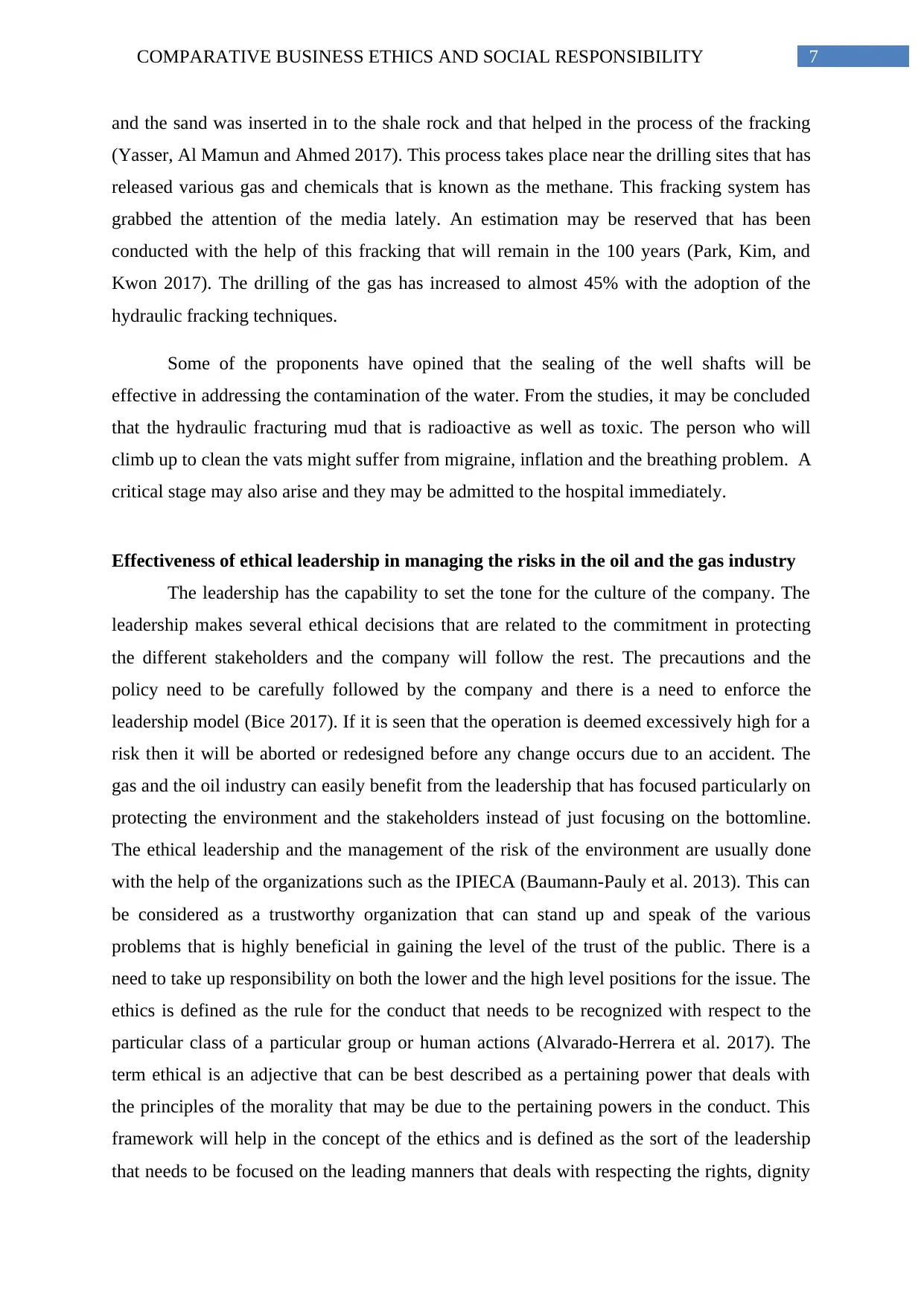
7COMPARATIVE BUSINESS ETHICS AND SOCIAL RESPONSIBILITY
and the sand was inserted in to the shale rock and that helped in the process of the fracking
(Yasser, Al Mamun and Ahmed 2017). This process takes place near the drilling sites that has
released various gas and chemicals that is known as the methane. This fracking system has
grabbed the attention of the media lately. An estimation may be reserved that has been
conducted with the help of this fracking that will remain in the 100 years (Park, Kim, and
Kwon 2017). The drilling of the gas has increased to almost 45% with the adoption of the
hydraulic fracking techniques.
Some of the proponents have opined that the sealing of the well shafts will be
effective in addressing the contamination of the water. From the studies, it may be concluded
that the hydraulic fracturing mud that is radioactive as well as toxic. The person who will
climb up to clean the vats might suffer from migraine, inflation and the breathing problem. A
critical stage may also arise and they may be admitted to the hospital immediately.
Effectiveness of ethical leadership in managing the risks in the oil and the gas industry
The leadership has the capability to set the tone for the culture of the company. The
leadership makes several ethical decisions that are related to the commitment in protecting
the different stakeholders and the company will follow the rest. The precautions and the
policy need to be carefully followed by the company and there is a need to enforce the
leadership model (Bice 2017). If it is seen that the operation is deemed excessively high for a
risk then it will be aborted or redesigned before any change occurs due to an accident. The
gas and the oil industry can easily benefit from the leadership that has focused particularly on
protecting the environment and the stakeholders instead of just focusing on the bottomline.
The ethical leadership and the management of the risk of the environment are usually done
with the help of the organizations such as the IPIECA (Baumann-Pauly et al. 2013). This can
be considered as a trustworthy organization that can stand up and speak of the various
problems that is highly beneficial in gaining the level of the trust of the public. There is a
need to take up responsibility on both the lower and the high level positions for the issue. The
ethics is defined as the rule for the conduct that needs to be recognized with respect to the
particular class of a particular group or human actions (Alvarado-Herrera et al. 2017). The
term ethical is an adjective that can be best described as a pertaining power that deals with
the principles of the morality that may be due to the pertaining powers in the conduct. This
framework will help in the concept of the ethics and is defined as the sort of the leadership
that needs to be focused on the leading manners that deals with respecting the rights, dignity
and the sand was inserted in to the shale rock and that helped in the process of the fracking
(Yasser, Al Mamun and Ahmed 2017). This process takes place near the drilling sites that has
released various gas and chemicals that is known as the methane. This fracking system has
grabbed the attention of the media lately. An estimation may be reserved that has been
conducted with the help of this fracking that will remain in the 100 years (Park, Kim, and
Kwon 2017). The drilling of the gas has increased to almost 45% with the adoption of the
hydraulic fracking techniques.
Some of the proponents have opined that the sealing of the well shafts will be
effective in addressing the contamination of the water. From the studies, it may be concluded
that the hydraulic fracturing mud that is radioactive as well as toxic. The person who will
climb up to clean the vats might suffer from migraine, inflation and the breathing problem. A
critical stage may also arise and they may be admitted to the hospital immediately.
Effectiveness of ethical leadership in managing the risks in the oil and the gas industry
The leadership has the capability to set the tone for the culture of the company. The
leadership makes several ethical decisions that are related to the commitment in protecting
the different stakeholders and the company will follow the rest. The precautions and the
policy need to be carefully followed by the company and there is a need to enforce the
leadership model (Bice 2017). If it is seen that the operation is deemed excessively high for a
risk then it will be aborted or redesigned before any change occurs due to an accident. The
gas and the oil industry can easily benefit from the leadership that has focused particularly on
protecting the environment and the stakeholders instead of just focusing on the bottomline.
The ethical leadership and the management of the risk of the environment are usually done
with the help of the organizations such as the IPIECA (Baumann-Pauly et al. 2013). This can
be considered as a trustworthy organization that can stand up and speak of the various
problems that is highly beneficial in gaining the level of the trust of the public. There is a
need to take up responsibility on both the lower and the high level positions for the issue. The
ethics is defined as the rule for the conduct that needs to be recognized with respect to the
particular class of a particular group or human actions (Alvarado-Herrera et al. 2017). The
term ethical is an adjective that can be best described as a pertaining power that deals with
the principles of the morality that may be due to the pertaining powers in the conduct. This
framework will help in the concept of the ethics and is defined as the sort of the leadership
that needs to be focused on the leading manners that deals with respecting the rights, dignity
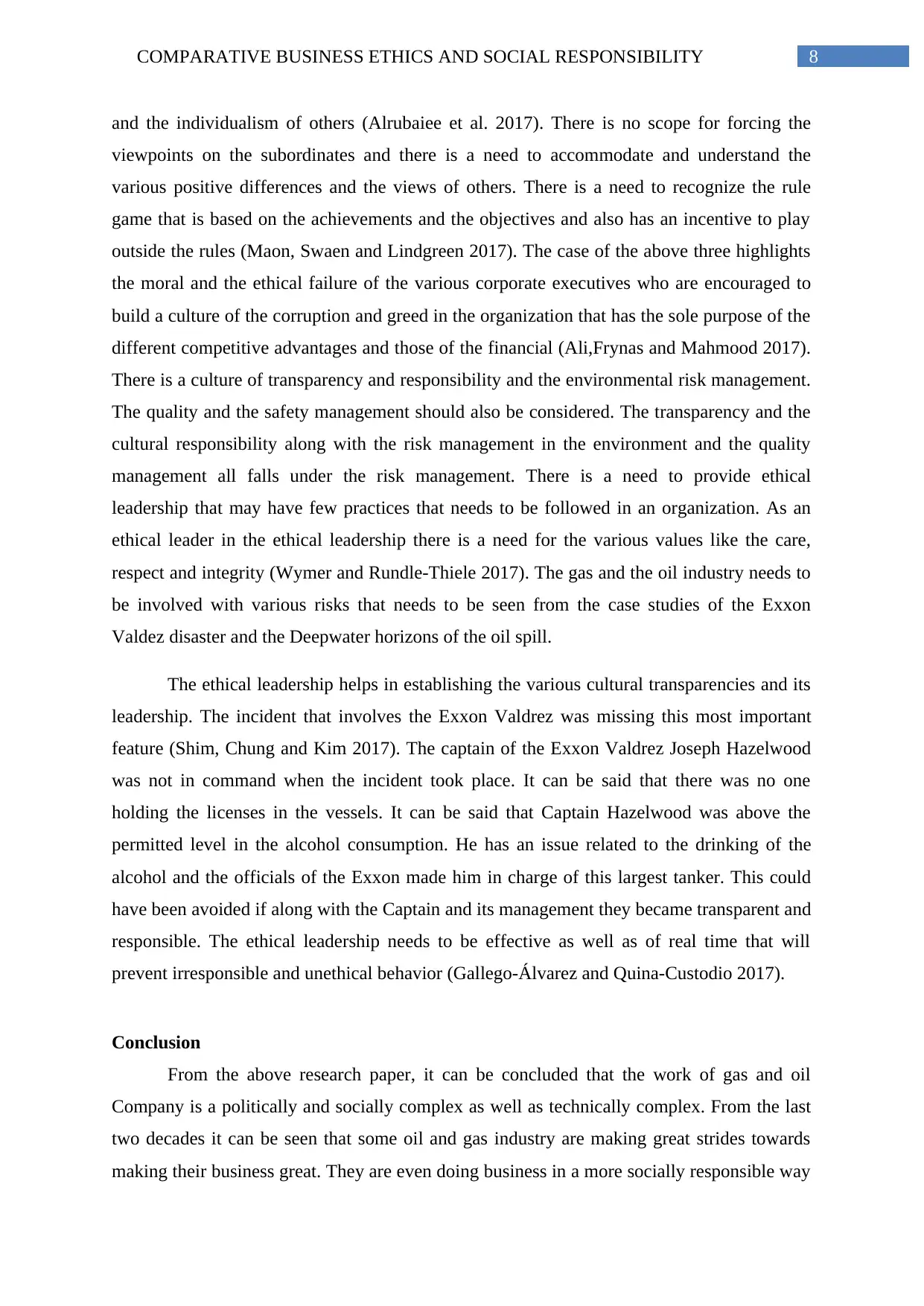
8COMPARATIVE BUSINESS ETHICS AND SOCIAL RESPONSIBILITY
and the individualism of others (Alrubaiee et al. 2017). There is no scope for forcing the
viewpoints on the subordinates and there is a need to accommodate and understand the
various positive differences and the views of others. There is a need to recognize the rule
game that is based on the achievements and the objectives and also has an incentive to play
outside the rules (Maon, Swaen and Lindgreen 2017). The case of the above three highlights
the moral and the ethical failure of the various corporate executives who are encouraged to
build a culture of the corruption and greed in the organization that has the sole purpose of the
different competitive advantages and those of the financial (Ali,Frynas and Mahmood 2017).
There is a culture of transparency and responsibility and the environmental risk management.
The quality and the safety management should also be considered. The transparency and the
cultural responsibility along with the risk management in the environment and the quality
management all falls under the risk management. There is a need to provide ethical
leadership that may have few practices that needs to be followed in an organization. As an
ethical leader in the ethical leadership there is a need for the various values like the care,
respect and integrity (Wymer and Rundle-Thiele 2017). The gas and the oil industry needs to
be involved with various risks that needs to be seen from the case studies of the Exxon
Valdez disaster and the Deepwater horizons of the oil spill.
The ethical leadership helps in establishing the various cultural transparencies and its
leadership. The incident that involves the Exxon Valdrez was missing this most important
feature (Shim, Chung and Kim 2017). The captain of the Exxon Valdrez Joseph Hazelwood
was not in command when the incident took place. It can be said that there was no one
holding the licenses in the vessels. It can be said that Captain Hazelwood was above the
permitted level in the alcohol consumption. He has an issue related to the drinking of the
alcohol and the officials of the Exxon made him in charge of this largest tanker. This could
have been avoided if along with the Captain and its management they became transparent and
responsible. The ethical leadership needs to be effective as well as of real time that will
prevent irresponsible and unethical behavior (Gallego‐Álvarez and Quina‐Custodio 2017).
Conclusion
From the above research paper, it can be concluded that the work of gas and oil
Company is a politically and socially complex as well as technically complex. From the last
two decades it can be seen that some oil and gas industry are making great strides towards
making their business great. They are even doing business in a more socially responsible way
and the individualism of others (Alrubaiee et al. 2017). There is no scope for forcing the
viewpoints on the subordinates and there is a need to accommodate and understand the
various positive differences and the views of others. There is a need to recognize the rule
game that is based on the achievements and the objectives and also has an incentive to play
outside the rules (Maon, Swaen and Lindgreen 2017). The case of the above three highlights
the moral and the ethical failure of the various corporate executives who are encouraged to
build a culture of the corruption and greed in the organization that has the sole purpose of the
different competitive advantages and those of the financial (Ali,Frynas and Mahmood 2017).
There is a culture of transparency and responsibility and the environmental risk management.
The quality and the safety management should also be considered. The transparency and the
cultural responsibility along with the risk management in the environment and the quality
management all falls under the risk management. There is a need to provide ethical
leadership that may have few practices that needs to be followed in an organization. As an
ethical leader in the ethical leadership there is a need for the various values like the care,
respect and integrity (Wymer and Rundle-Thiele 2017). The gas and the oil industry needs to
be involved with various risks that needs to be seen from the case studies of the Exxon
Valdez disaster and the Deepwater horizons of the oil spill.
The ethical leadership helps in establishing the various cultural transparencies and its
leadership. The incident that involves the Exxon Valdrez was missing this most important
feature (Shim, Chung and Kim 2017). The captain of the Exxon Valdrez Joseph Hazelwood
was not in command when the incident took place. It can be said that there was no one
holding the licenses in the vessels. It can be said that Captain Hazelwood was above the
permitted level in the alcohol consumption. He has an issue related to the drinking of the
alcohol and the officials of the Exxon made him in charge of this largest tanker. This could
have been avoided if along with the Captain and its management they became transparent and
responsible. The ethical leadership needs to be effective as well as of real time that will
prevent irresponsible and unethical behavior (Gallego‐Álvarez and Quina‐Custodio 2017).
Conclusion
From the above research paper, it can be concluded that the work of gas and oil
Company is a politically and socially complex as well as technically complex. From the last
two decades it can be seen that some oil and gas industry are making great strides towards
making their business great. They are even doing business in a more socially responsible way
You're viewing a preview
Unlock full access by subscribing today!
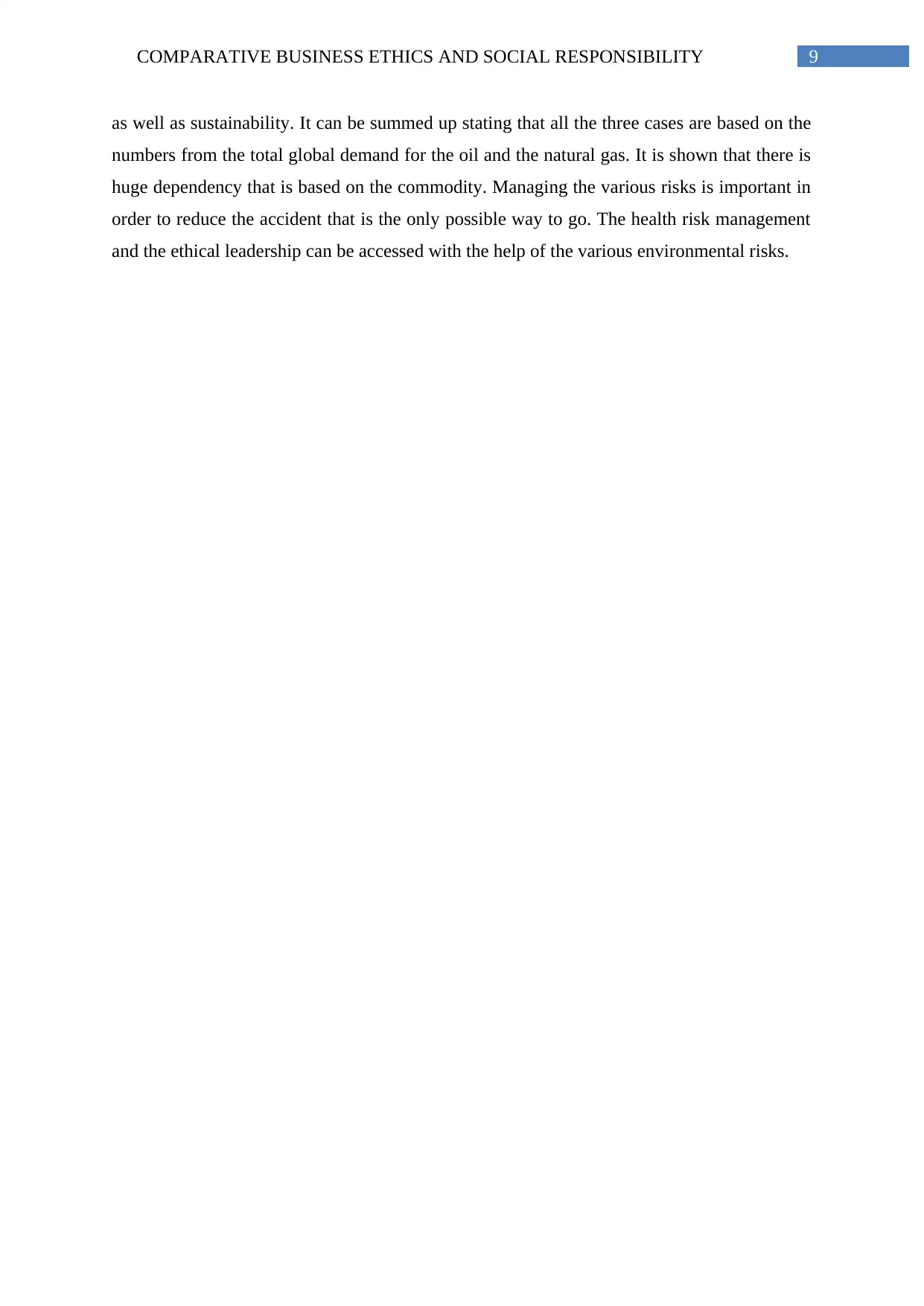
9COMPARATIVE BUSINESS ETHICS AND SOCIAL RESPONSIBILITY
as well as sustainability. It can be summed up stating that all the three cases are based on the
numbers from the total global demand for the oil and the natural gas. It is shown that there is
huge dependency that is based on the commodity. Managing the various risks is important in
order to reduce the accident that is the only possible way to go. The health risk management
and the ethical leadership can be accessed with the help of the various environmental risks.
as well as sustainability. It can be summed up stating that all the three cases are based on the
numbers from the total global demand for the oil and the natural gas. It is shown that there is
huge dependency that is based on the commodity. Managing the various risks is important in
order to reduce the accident that is the only possible way to go. The health risk management
and the ethical leadership can be accessed with the help of the various environmental risks.
Paraphrase This Document
Need a fresh take? Get an instant paraphrase of this document with our AI Paraphraser
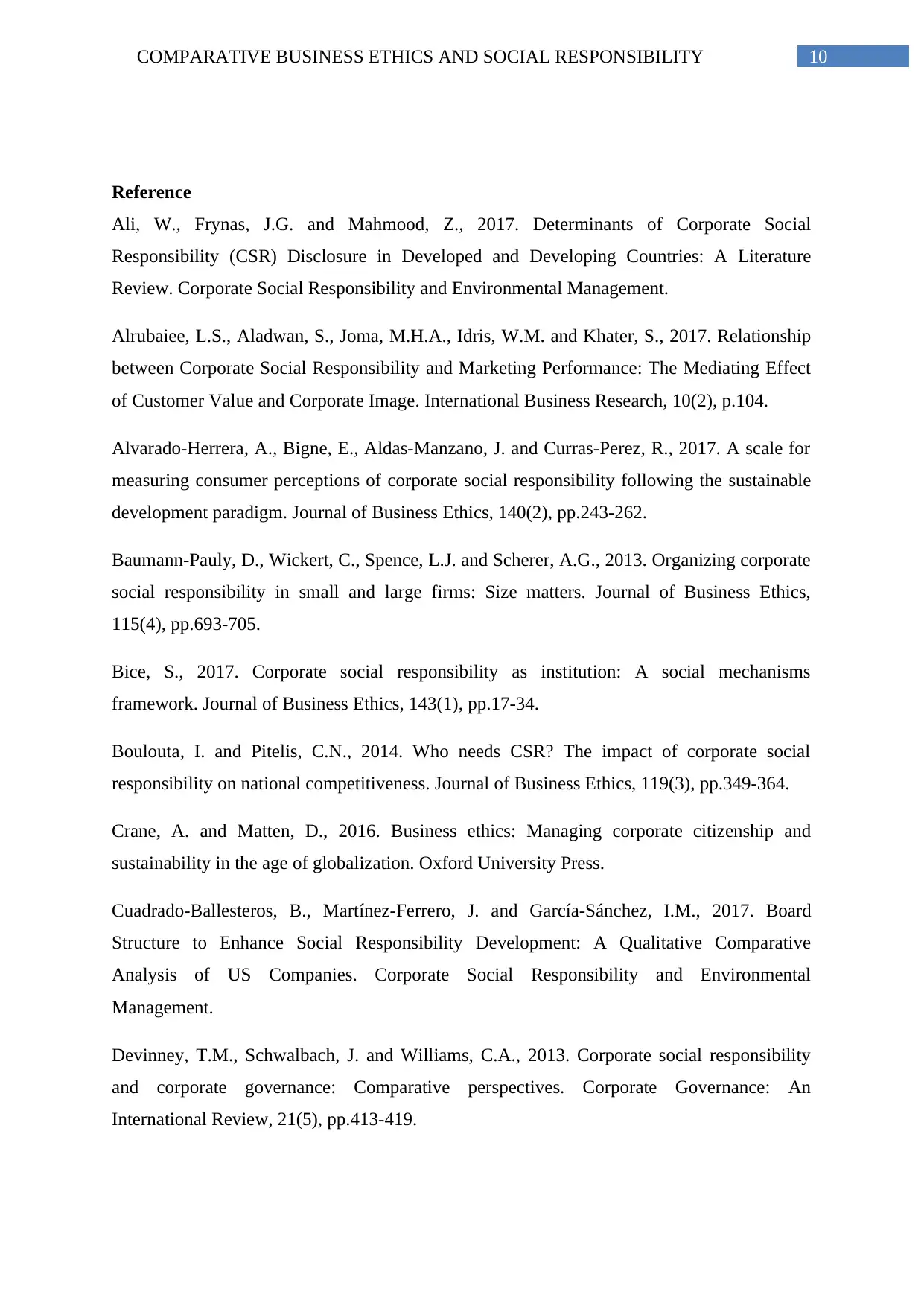
10COMPARATIVE BUSINESS ETHICS AND SOCIAL RESPONSIBILITY
Reference
Ali, W., Frynas, J.G. and Mahmood, Z., 2017. Determinants of Corporate Social
Responsibility (CSR) Disclosure in Developed and Developing Countries: A Literature
Review. Corporate Social Responsibility and Environmental Management.
Alrubaiee, L.S., Aladwan, S., Joma, M.H.A., Idris, W.M. and Khater, S., 2017. Relationship
between Corporate Social Responsibility and Marketing Performance: The Mediating Effect
of Customer Value and Corporate Image. International Business Research, 10(2), p.104.
Alvarado-Herrera, A., Bigne, E., Aldas-Manzano, J. and Curras-Perez, R., 2017. A scale for
measuring consumer perceptions of corporate social responsibility following the sustainable
development paradigm. Journal of Business Ethics, 140(2), pp.243-262.
Baumann-Pauly, D., Wickert, C., Spence, L.J. and Scherer, A.G., 2013. Organizing corporate
social responsibility in small and large firms: Size matters. Journal of Business Ethics,
115(4), pp.693-705.
Bice, S., 2017. Corporate social responsibility as institution: A social mechanisms
framework. Journal of Business Ethics, 143(1), pp.17-34.
Boulouta, I. and Pitelis, C.N., 2014. Who needs CSR? The impact of corporate social
responsibility on national competitiveness. Journal of Business Ethics, 119(3), pp.349-364.
Crane, A. and Matten, D., 2016. Business ethics: Managing corporate citizenship and
sustainability in the age of globalization. Oxford University Press.
Cuadrado‐Ballesteros, B., Martínez‐Ferrero, J. and García‐Sánchez, I.M., 2017. Board
Structure to Enhance Social Responsibility Development: A Qualitative Comparative
Analysis of US Companies. Corporate Social Responsibility and Environmental
Management.
Devinney, T.M., Schwalbach, J. and Williams, C.A., 2013. Corporate social responsibility
and corporate governance: Comparative perspectives. Corporate Governance: An
International Review, 21(5), pp.413-419.
Reference
Ali, W., Frynas, J.G. and Mahmood, Z., 2017. Determinants of Corporate Social
Responsibility (CSR) Disclosure in Developed and Developing Countries: A Literature
Review. Corporate Social Responsibility and Environmental Management.
Alrubaiee, L.S., Aladwan, S., Joma, M.H.A., Idris, W.M. and Khater, S., 2017. Relationship
between Corporate Social Responsibility and Marketing Performance: The Mediating Effect
of Customer Value and Corporate Image. International Business Research, 10(2), p.104.
Alvarado-Herrera, A., Bigne, E., Aldas-Manzano, J. and Curras-Perez, R., 2017. A scale for
measuring consumer perceptions of corporate social responsibility following the sustainable
development paradigm. Journal of Business Ethics, 140(2), pp.243-262.
Baumann-Pauly, D., Wickert, C., Spence, L.J. and Scherer, A.G., 2013. Organizing corporate
social responsibility in small and large firms: Size matters. Journal of Business Ethics,
115(4), pp.693-705.
Bice, S., 2017. Corporate social responsibility as institution: A social mechanisms
framework. Journal of Business Ethics, 143(1), pp.17-34.
Boulouta, I. and Pitelis, C.N., 2014. Who needs CSR? The impact of corporate social
responsibility on national competitiveness. Journal of Business Ethics, 119(3), pp.349-364.
Crane, A. and Matten, D., 2016. Business ethics: Managing corporate citizenship and
sustainability in the age of globalization. Oxford University Press.
Cuadrado‐Ballesteros, B., Martínez‐Ferrero, J. and García‐Sánchez, I.M., 2017. Board
Structure to Enhance Social Responsibility Development: A Qualitative Comparative
Analysis of US Companies. Corporate Social Responsibility and Environmental
Management.
Devinney, T.M., Schwalbach, J. and Williams, C.A., 2013. Corporate social responsibility
and corporate governance: Comparative perspectives. Corporate Governance: An
International Review, 21(5), pp.413-419.
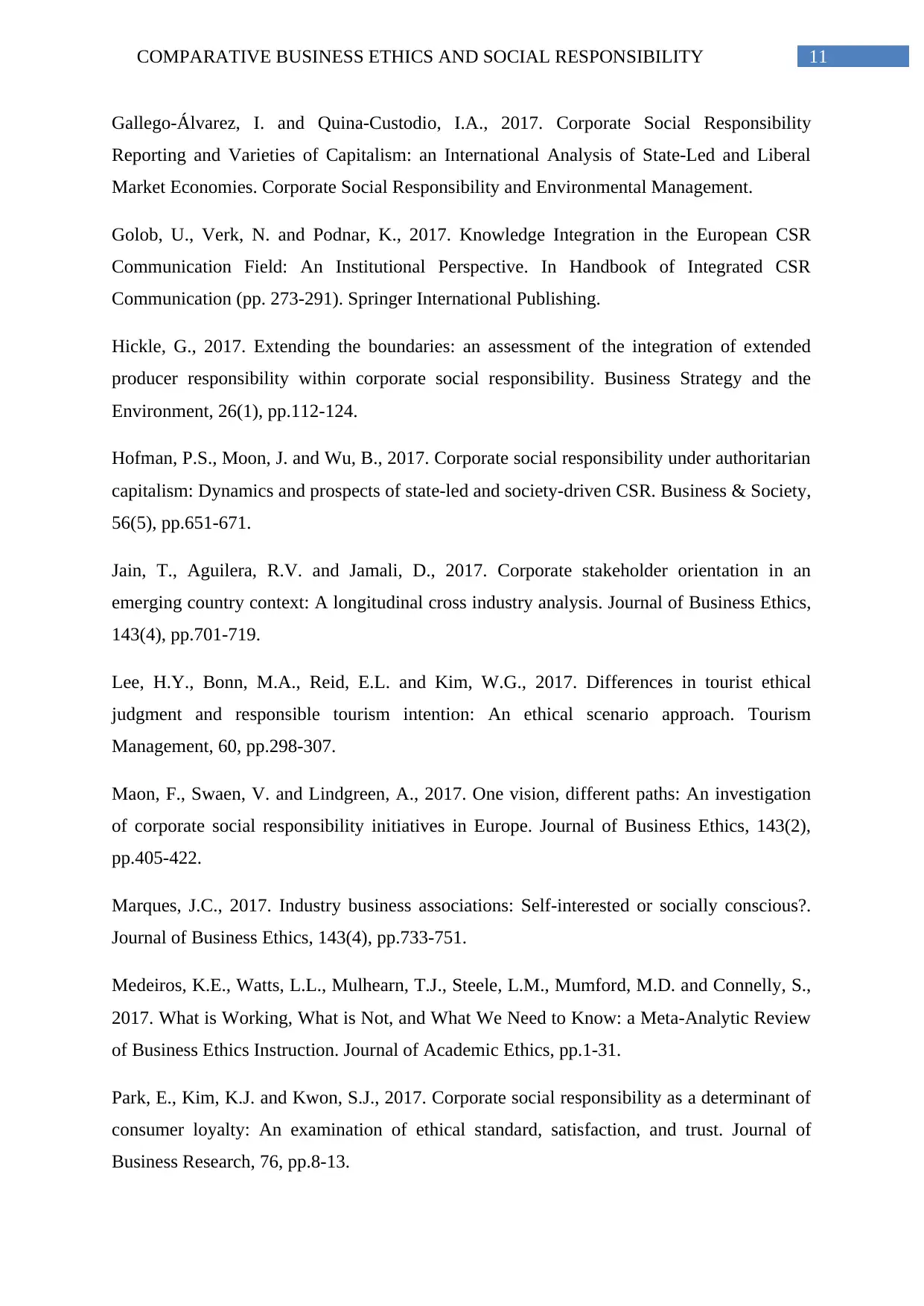
11COMPARATIVE BUSINESS ETHICS AND SOCIAL RESPONSIBILITY
Gallego‐Álvarez, I. and Quina‐Custodio, I.A., 2017. Corporate Social Responsibility
Reporting and Varieties of Capitalism: an International Analysis of State‐Led and Liberal
Market Economies. Corporate Social Responsibility and Environmental Management.
Golob, U., Verk, N. and Podnar, K., 2017. Knowledge Integration in the European CSR
Communication Field: An Institutional Perspective. In Handbook of Integrated CSR
Communication (pp. 273-291). Springer International Publishing.
Hickle, G., 2017. Extending the boundaries: an assessment of the integration of extended
producer responsibility within corporate social responsibility. Business Strategy and the
Environment, 26(1), pp.112-124.
Hofman, P.S., Moon, J. and Wu, B., 2017. Corporate social responsibility under authoritarian
capitalism: Dynamics and prospects of state-led and society-driven CSR. Business & Society,
56(5), pp.651-671.
Jain, T., Aguilera, R.V. and Jamali, D., 2017. Corporate stakeholder orientation in an
emerging country context: A longitudinal cross industry analysis. Journal of Business Ethics,
143(4), pp.701-719.
Lee, H.Y., Bonn, M.A., Reid, E.L. and Kim, W.G., 2017. Differences in tourist ethical
judgment and responsible tourism intention: An ethical scenario approach. Tourism
Management, 60, pp.298-307.
Maon, F., Swaen, V. and Lindgreen, A., 2017. One vision, different paths: An investigation
of corporate social responsibility initiatives in Europe. Journal of Business Ethics, 143(2),
pp.405-422.
Marques, J.C., 2017. Industry business associations: Self-interested or socially conscious?.
Journal of Business Ethics, 143(4), pp.733-751.
Medeiros, K.E., Watts, L.L., Mulhearn, T.J., Steele, L.M., Mumford, M.D. and Connelly, S.,
2017. What is Working, What is Not, and What We Need to Know: a Meta-Analytic Review
of Business Ethics Instruction. Journal of Academic Ethics, pp.1-31.
Park, E., Kim, K.J. and Kwon, S.J., 2017. Corporate social responsibility as a determinant of
consumer loyalty: An examination of ethical standard, satisfaction, and trust. Journal of
Business Research, 76, pp.8-13.
Gallego‐Álvarez, I. and Quina‐Custodio, I.A., 2017. Corporate Social Responsibility
Reporting and Varieties of Capitalism: an International Analysis of State‐Led and Liberal
Market Economies. Corporate Social Responsibility and Environmental Management.
Golob, U., Verk, N. and Podnar, K., 2017. Knowledge Integration in the European CSR
Communication Field: An Institutional Perspective. In Handbook of Integrated CSR
Communication (pp. 273-291). Springer International Publishing.
Hickle, G., 2017. Extending the boundaries: an assessment of the integration of extended
producer responsibility within corporate social responsibility. Business Strategy and the
Environment, 26(1), pp.112-124.
Hofman, P.S., Moon, J. and Wu, B., 2017. Corporate social responsibility under authoritarian
capitalism: Dynamics and prospects of state-led and society-driven CSR. Business & Society,
56(5), pp.651-671.
Jain, T., Aguilera, R.V. and Jamali, D., 2017. Corporate stakeholder orientation in an
emerging country context: A longitudinal cross industry analysis. Journal of Business Ethics,
143(4), pp.701-719.
Lee, H.Y., Bonn, M.A., Reid, E.L. and Kim, W.G., 2017. Differences in tourist ethical
judgment and responsible tourism intention: An ethical scenario approach. Tourism
Management, 60, pp.298-307.
Maon, F., Swaen, V. and Lindgreen, A., 2017. One vision, different paths: An investigation
of corporate social responsibility initiatives in Europe. Journal of Business Ethics, 143(2),
pp.405-422.
Marques, J.C., 2017. Industry business associations: Self-interested or socially conscious?.
Journal of Business Ethics, 143(4), pp.733-751.
Medeiros, K.E., Watts, L.L., Mulhearn, T.J., Steele, L.M., Mumford, M.D. and Connelly, S.,
2017. What is Working, What is Not, and What We Need to Know: a Meta-Analytic Review
of Business Ethics Instruction. Journal of Academic Ethics, pp.1-31.
Park, E., Kim, K.J. and Kwon, S.J., 2017. Corporate social responsibility as a determinant of
consumer loyalty: An examination of ethical standard, satisfaction, and trust. Journal of
Business Research, 76, pp.8-13.
You're viewing a preview
Unlock full access by subscribing today!
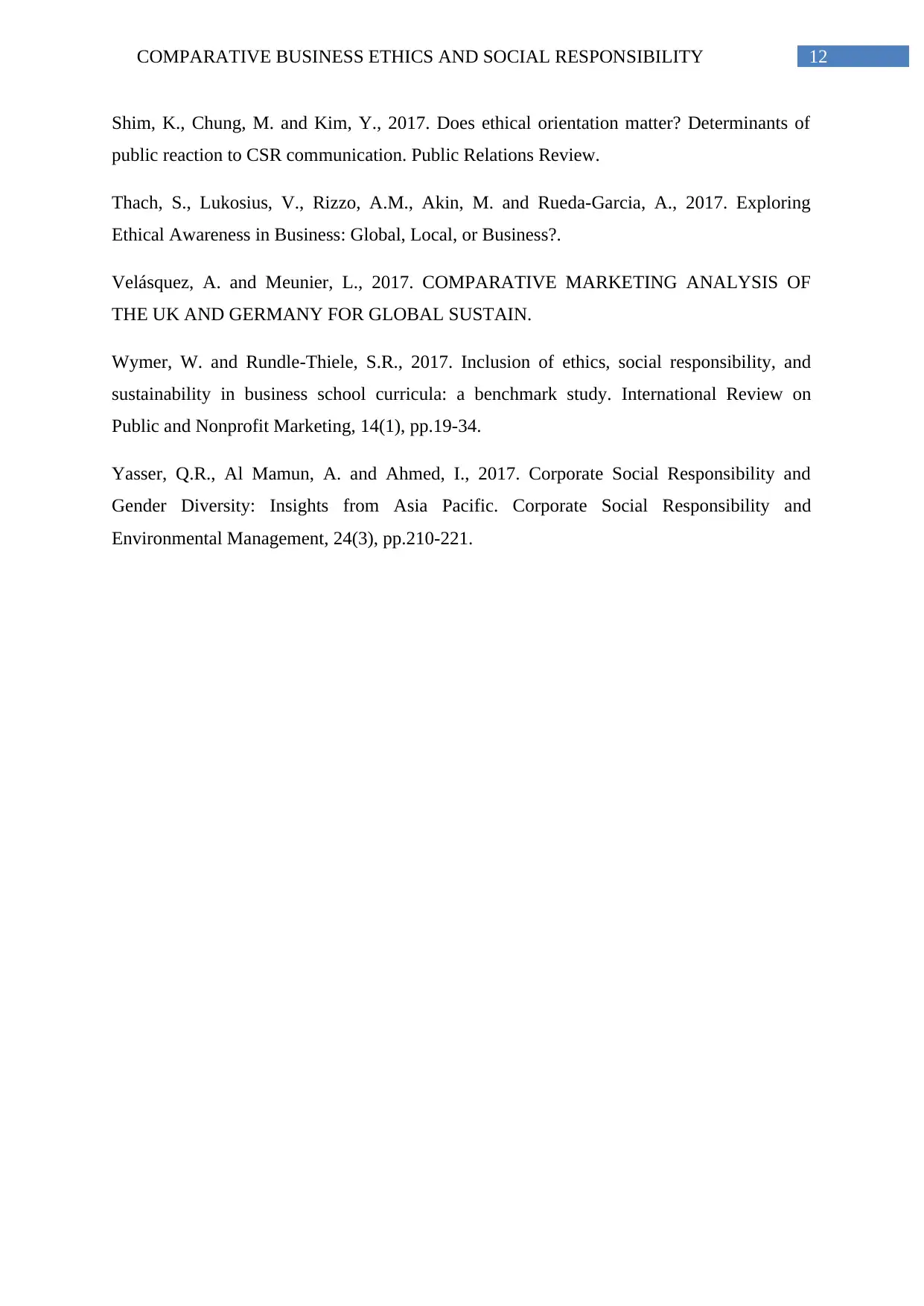
12COMPARATIVE BUSINESS ETHICS AND SOCIAL RESPONSIBILITY
Shim, K., Chung, M. and Kim, Y., 2017. Does ethical orientation matter? Determinants of
public reaction to CSR communication. Public Relations Review.
Thach, S., Lukosius, V., Rizzo, A.M., Akin, M. and Rueda-Garcia, A., 2017. Exploring
Ethical Awareness in Business: Global, Local, or Business?.
Velásquez, A. and Meunier, L., 2017. COMPARATIVE MARKETING ANALYSIS OF
THE UK AND GERMANY FOR GLOBAL SUSTAIN.
Wymer, W. and Rundle-Thiele, S.R., 2017. Inclusion of ethics, social responsibility, and
sustainability in business school curricula: a benchmark study. International Review on
Public and Nonprofit Marketing, 14(1), pp.19-34.
Yasser, Q.R., Al Mamun, A. and Ahmed, I., 2017. Corporate Social Responsibility and
Gender Diversity: Insights from Asia Pacific. Corporate Social Responsibility and
Environmental Management, 24(3), pp.210-221.
Shim, K., Chung, M. and Kim, Y., 2017. Does ethical orientation matter? Determinants of
public reaction to CSR communication. Public Relations Review.
Thach, S., Lukosius, V., Rizzo, A.M., Akin, M. and Rueda-Garcia, A., 2017. Exploring
Ethical Awareness in Business: Global, Local, or Business?.
Velásquez, A. and Meunier, L., 2017. COMPARATIVE MARKETING ANALYSIS OF
THE UK AND GERMANY FOR GLOBAL SUSTAIN.
Wymer, W. and Rundle-Thiele, S.R., 2017. Inclusion of ethics, social responsibility, and
sustainability in business school curricula: a benchmark study. International Review on
Public and Nonprofit Marketing, 14(1), pp.19-34.
Yasser, Q.R., Al Mamun, A. and Ahmed, I., 2017. Corporate Social Responsibility and
Gender Diversity: Insights from Asia Pacific. Corporate Social Responsibility and
Environmental Management, 24(3), pp.210-221.
1 out of 13
Related Documents
Your All-in-One AI-Powered Toolkit for Academic Success.
+13062052269
info@desklib.com
Available 24*7 on WhatsApp / Email
![[object Object]](/_next/static/media/star-bottom.7253800d.svg)
Unlock your academic potential
© 2024 | Zucol Services PVT LTD | All rights reserved.





